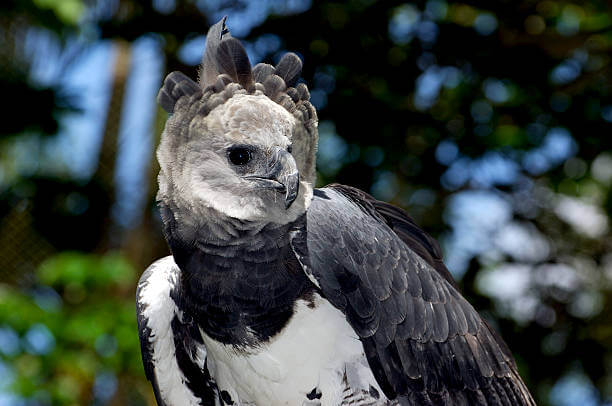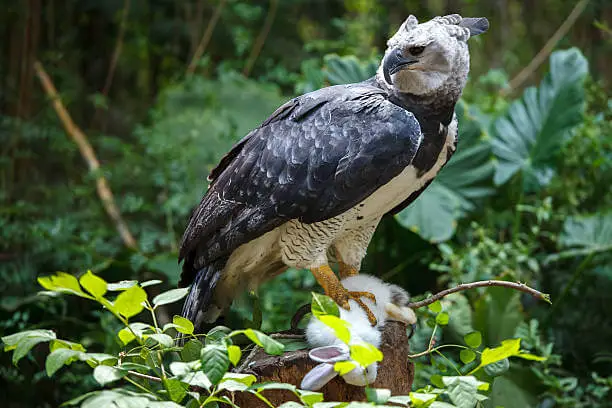Step into the magical world of the Harpy Eagle, a magnificent creature that reigns supreme in the rainforests of Central and South America. With its majestic appearance and extraordinary hunting abilities, the Harpy Eagle is a true force to be reckoned with.
Standing at about three feet tall and boasting a wingspan of up to seven feet, the Harpy Eagle is one of the largest and most powerful birds of prey in the world. Its captivating features, including piercing yellow eyes, a prominent crest, and formidable talons, make it both awe-inspiring and mysterious.
This article takes you on a fascinating journey into the world of the Harpy Eagle, shedding light on its unique characteristics, habitat, and conservation efforts. Discover how this elusive species has adapted to survive in the dense rainforests and learn about its crucial role in maintaining the delicate balance of the ecosystem.
From its elusive nature to its remarkable hunting skills, the Harpy Eagle has captivated the imaginations of wildlife enthusiasts and researchers alike. Join us on this captivating exploration of a rare species that truly deserves the title of the “Majestic Harpy Eagle.”
Physical characteristics of the Harpy Eagle

The Harpy Eagle is a sight to behold, with its awe-inspiring size and striking appearance. It stands tall at about three feet and has a wingspan that can reach up to seven feet. Its impressive size and muscular build make it one of the largest and most powerful birds of prey in the world.
The Harpy Eagle’s most striking features are its piercing yellow eyes, which give it an intense and commanding presence. Its prominent crest, made up of long feathers, adds to its regal appearance. The Harpy Eagle also possesses formidable talons, which can measure up to five inches in length, enabling it to capture and kill its prey with ease.
Habitat and distribution of the Harpy Eagle
The Harpy Eagle is predominantly found in the tropical rainforests of Central and South America. Its habitat stretches from Mexico to Brazil and encompasses countries such as Belize, Colombia, Ecuador, and Peru.
These birds prefer undisturbed primary rainforests with dense canopies, as they provide them with the ideal hunting grounds and nesting sites. Unfortunately, due to deforestation and habitat destruction, the Harpy Eagle’s range has significantly decreased over the years, making it a rare and elusive species.
Also Read:- Unlocking the Secrets of Bluebirds
Diet and hunting behavior of the Harpy Eagle
The Harpy Eagle is a formidable predator and is known for its exceptional hunting skills. Its diet primarily consists of medium-sized mammals, such as sloths, monkeys, and tree-dwelling rodents. The Harpy Eagle’s large size and powerful talons allow it to capture and carry off prey that can weigh up to half of its own body weight.
With its keen eyesight, the Harpy Eagle can spot its prey from great distances while flying high above the forest canopy. Once it has located its target, it swoops down in a swift and silent manner, using its powerful wings to navigate through the dense vegetation. Its lightning-fast attack and razor-sharp talons ensure a swift and efficient kill.
Reproduction and nesting habits of the Harpy Eagle
The Harpy Eagle’s breeding season typically occurs between December and June. During this time, the male and female Harpy Eagles engage in elaborate courtship displays, which involve aerial acrobatics and vocalizations. Once a pair has formed a bond, they will mate and build a large, sturdy nest in the upper canopy of the rainforest.
The nest, made primarily of sticks and branches, can measure up to six feet in diameter and weigh hundreds of pounds. The female Harpy Eagle will lay a single egg, which both parents take turns incubating for about 50 to 56 days. After hatching, the chick is cared for by both parents and will remain in the nest for approximately six to ten months before venturing out on its own.
Threats and conservation status of the Harpy Eagle
The Harpy Eagle faces numerous threats to its survival, primarily due to habitat loss and human activities. Deforestation, illegal logging, and land conversion for agriculture have significantly reduced the Harpy Eagle’s habitat, making it increasingly difficult for these birds to find suitable nesting and hunting grounds.
Additionally, the Harpy Eagle is often targeted by hunters and poachers who view it as a threat to livestock or a prized trophy. These combined factors have led to a decline in the Harpy Eagle population, resulting in its classification as Near Threatened on the IUCN Red List of Threatened Species.
Interesting facts about the Harpy Eagle
– The Harpy Eagle is named after the harpies of Greek mythology, which were winged creatures with the faces of women and the bodies of birds.
– Harpy Eagles have been observed flying at speeds of up to 50 miles per hour.
– The Harpy Eagle has a unique hunting technique called “still-hunting,” where it perches silently on a high vantage point, waiting for unsuspecting prey to pass by.
– These birds have a distinct call, which is often described as a loud, piercing scream that echoes through the rainforest.
– Harpy Eagles have a lifespan of approximately 25 to 35 years in the wild.
Must Read:- The Biggest Birds in the World
The role of the Harpy Eagle in its ecosystem
As one of the top predators in the rainforest, the Harpy Eagle plays a crucial role in maintaining the delicate balance of the ecosystem. By hunting and controlling the population of medium-sized mammals, the Harpy Eagle helps regulate their numbers and prevents overpopulation. This, in turn, ensures the health and stability of the rainforest ecosystem.
The Harpy Eagle’s diet primarily consists of sloths, which are known to move slowly and spend most of their lives in trees. By preying on sloths, the Harpy Eagle helps keep their population in check, preventing them from causing excessive damage to the rainforest vegetation.
Efforts and initiatives for the conservation of the Harpy Eagle
Recognizing the importance of conserving this magnificent species, numerous organizations and initiatives have been established to protect the Harpy Eagle and its habitat. These efforts focus on habitat preservation, anti-poaching measures, and public awareness campaigns.
Protected areas and national parks have been established to safeguard the Harpy Eagle’s remaining habitat, providing a safe haven for these birds. Furthermore, educational programs and research projects aim to raise awareness about the Harpy Eagle’s plight and promote its conservation. By working together, we can ensure the survival of this rare and majestic species for generations to come.
Must Read:-
- What do wolves eat in the wild?
- Top 10 Birds in Africa
- Exploring the World’s 10 Rarest Animals
- The Biggest Eagles in the World
- 30 Types of Wild Dogs with Species & Images
Conclusion: Appreciating the beauty and importance of the Harpy Eagle
The Harpy Eagle is undeniably one of nature’s most awe-inspiring creatures. Its majestic appearance, extraordinary hunting abilities, and crucial role in the rainforest ecosystem make it a species deserving of our admiration and protection.
By understanding the unique characteristics, habitat, and conservation efforts surrounding the Harpy Eagle, we can appreciate the beauty and importance of this rare species. Let us strive to preserve its habitat and protect it from the threats it faces, ensuring that future generations can marvel at the majesty of the Harpy Eagle in the wild.

